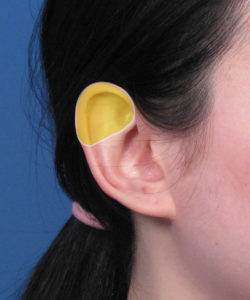 Macrotia can be simply defined as an ear that is excessively large in size. By direct measurement, the vertical height of the normal ear is a range of 55-65 millimeters in the adult patient. Another method of assessing overall size is comparing the ratio of width to height. Normally, this ratio should be 50-55%. Whenever either of these two measurements is beyond the normal range, the ear can appear excessively large – and be a source of concern for many patients suffering from macrotia.
Macrotia can be simply defined as an ear that is excessively large in size. By direct measurement, the vertical height of the normal ear is a range of 55-65 millimeters in the adult patient. Another method of assessing overall size is comparing the ratio of width to height. Normally, this ratio should be 50-55%. Whenever either of these two measurements is beyond the normal range, the ear can appear excessively large – and be a source of concern for many patients suffering from macrotia.
In most cases, macrotia results from an enlarged scapha. So what is the scapha of the ear you may be asking? The scapha is shown more visually (in yellow) in the adjacent patient photo and corresponds to the upper one-third of the ear. More specifically, the scapha is the more flattened portion of the ear that is bordered by the upper helical rim. Normally, the scapha is a fairly narrow segment that separates the helical rim from what is called the antihelix.  This is shown in the adjacent photo diagram where the upper helical rim is shaded in red and the antihelix is shaded in blue. In between these two is the scapha of the ear. In many patients seeking macrotia ear reduction surgery, the scapha is just too wide and gives the appearance the ear is overgrown in size. In these cases, the upper segment of the ear can look disproportionately large compared with the lower half. In other cases of macrotia, an enlarged scapha can make the ear look as if it is too ‘pointy’ along the upper segment – reflecting the fact the ear is too narrow because of the extra vertical length.
This is shown in the adjacent photo diagram where the upper helical rim is shaded in red and the antihelix is shaded in blue. In between these two is the scapha of the ear. In many patients seeking macrotia ear reduction surgery, the scapha is just too wide and gives the appearance the ear is overgrown in size. In these cases, the upper segment of the ear can look disproportionately large compared with the lower half. In other cases of macrotia, an enlarged scapha can make the ear look as if it is too ‘pointy’ along the upper segment – reflecting the fact the ear is too narrow because of the extra vertical length.
Scapha Enlargement Examples
Provided here is a sample display of various ears that all display scapha enlargement to some degree. In some cases (like patients A and B), the upper segment of the ear has that ‘pointy’ appearance alluded to previously. In others (like patients C, D, and E), the upper segment of the ear simply looks too wide. But a common characteristic among all five of these patients is the fact their scapha is abnormally prominent.

The treatment for macrotia, therefore, should focus on making the scapha smaller in size by removing the excess cartilage between the helical rim and the antihelix. In doing so, the upper portion of the ear can be made to better match the size of the lower portion of the ear.
Macrotia Consult
If you have large ears and are considering cosmetic ear surgery to make your ears smaller in size, feel free to contact our office today to consult with one of the nation’s true experts in making smaller ears, Dr. John Hilinski.
